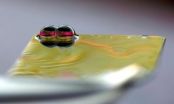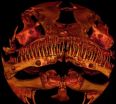(Press-News.org) OAK RIDGE, Tenn., May 13, 2014 -- A simple new technique to form interlocking beads of water in ambient conditions could prove valuable for applications in biological sensing, membrane research and harvesting water from fog.
Researchers at the Department of Energy's Oak Ridge National Laboratory have developed a method to create air-stable water droplet networks known as droplet interface bilayers. These interconnected water droplets have many roles in biological research because their interfaces simulate cell membranes. Cumbersome fabrication methods, however, have limited their use.
"The way they've been made since their inception is that two water droplets are formed in an oil bath then brought together while they're submerged in oil," said ORNL's Pat Collier, who led the team's study published in the Proceedings of the National Academy of Sciences. "Otherwise they would just pop like soap bubbles."
Instead of injecting water droplets into an oil bath, the ORNL research team experimented with placing the droplets on a superhydrophobic surface infused with a coating of oil. The droplets aligned side by side without merging.
To the researchers' surprise, they were also able to form non-coalescing water droplet networks without including lipids in the water solution. Scientists typically incorporate phospholipids into the water mixture, which leads to the formation of an interlocking lipid bilayer between the water droplets.
"When you have those lipids at the interfaces of the water drops, it's well known that they won't coalesce because the interfaces join together and form a stable bilayer," ORNL coauthor Jonathan Boreyko said. "So our surprise was that even without lipids in the system, the pure water droplets on an oil-infused surface in air still don't coalesce together."
The team's research revealed how the unexpected effect is caused by a thin oil film that is squeezed between the pure water droplets as they come together, preventing the droplets from merging into one. Watch a video of the process on ORNL's YouTube channel.
With or without the addition of lipids, the team's technique offers new insight for a host of applications. Controlling the behavior of pure water droplets on oil-infused surfaces is key to developing dew- or fog-harvesting technology as well as more efficient condensers, for instance.
"Our finding of this non-coalescence phenomenon will shed light on these droplet-droplet interactions that can occur on oil-infused systems," Boreyko said.
The ability to create membrane-like water droplet networks by adding lipids leads to a different set of functional applications, Collier noted.
"These bilayers can be used in anything from synthetic biology to creating circuits to bio-sensing applications," he said. "For example, we could make a bio-battery or a signaling network by stringing some of these droplets together. Or, we could use it to sense the presence of airborne molecules."
The team's study also demonstrated ways to control the performance and lifetime of the water droplets by manipulating oil viscosity and temperature and humidity levels.
INFORMATION:
Coauthors include ORNL's Georgios Polizos and Panos Datskos, and the University of Tennessee's Stephen Sarles. The researchers have filed an invention disclosure on their technique.
This research was conducted at the Center for Nanophase Materials Sciences, which is sponsored at ORNL by the Scientific User Facilities Division in DOE's Office of Basic Energy Sciences. Funding was also provided by an Air Force Office of Scientific Research Basic Research Initiative grant and the SunShot Initiative within DOE's Office of Energy Efficiency and Renewable Energy.
CNMS is one of the five DOE Nanoscale Science Research Centers, NSRCs, supported by the DOE Office of Science, as premier national user facilities for interdisciplinary research at the nanoscale. Together the NSRCs comprise a suite of complementary facilities that provide researchers with state-of-the-art capabilities to fabricate, process, characterize and model nanoscale materials, and constitute the largest infrastructure investment of the National Nanotechnology Initiative. The NSRCs are located at DOE's Argonne, Brookhaven, Lawrence Berkeley, Oak Ridge and Sandia and Los Alamos national laboratories. For more information about the DOE NSRCs, please visit http://science.energy.gov/bes/suf/user-facilities/nanoscale-science-research-centers/.
UT-Battelle manages ORNL for DOE's Office of Science. The Office of Science is the single largest supporter of basic research in the physical sciences in the United States, and is working to address some of the most pressing challenges of our time. For more information, please visit http://science.energy.gov/.
Image: http://www.ornl.gov/Image%20Library/Main%20Nav/ORNL/News/News%20Releases/2014/water_droplet_hr.jpg?code=40054266-7baf-4b0f-bfe5-8b68d6678227
Caption: Researchers at the Department of Energy's Oak Ridge National Laboratory have developed a method to create air-stable water droplet networks that are valuable for applications in biological sensing and membrane research. Image credit: Kyle Kuykendall.
NOTE TO EDITORS: You may read other press releases from Oak Ridge National Laboratory or learn more about the lab at http://www.ornl.gov/news. Additional information about ORNL is available at the sites below:
Twitter - http://twitter.com/oakridgelabnews
RSS Feeds - http://www.ornl.gov/ornlhome/rss_feeds.shtml
Flickr - http://www.flickr.com/photos/oakridgelab
YouTube - http://www.youtube.com/user/OakRidgeNationalLab
LinkedIn - http://www.linkedin.com/companies/oak-ridge-national-laboratory
Facebook - http://www.facebook.com/Oak.Ridge.National.Laboratory
Novel ORNL technique enables air-stable water droplet networks
2014-05-13
ELSE PRESS RELEASES FROM THIS DATE:
Evolutionary biologists glimpse early stages of Y-chromosome degeneration
2014-05-13
TORONTO, ON – In many species, the possession of X and Y chromosomes determines whether an individual develops into a male or female. In humans, for example, individuals who inherit their father's Y chromosome become male (XY), and individuals who inherit their father's X chromosome become female (XX).
This system of sex determination has evolved independently multiple times and a striking feature of its evolution is that Y chromosomes have degenerated genetically, losing many genes over time. What is not well understood, however, is what happens to the Y chromosome during ...
Surprising global species shake-up discovered
2014-05-13
The diversity of the world's life forms — from corals to carnivores — is under assault. Decades of scientific studies document the fraying of ecosystems and a grim tally of species extinctions due to destroyed habitat, pollution, climate change, invasives and overharvesting.
Which makes a recent report in the journal Science rather surprising.
Nick Gotelli, a professor at the University of Vermont, with colleagues from Saint Andrews University, Scotland, and the University of Maine, re-examined data from one hundred long-term monitoring studies done around the world ...
Cancer stem cells under the microscope at Albert Einstein College of Medicine symposium
2014-05-13
May 13, 2014 – (BRONX, NY) – Healthy stem cells work to restore or repair the body's tissues, but cancer stem cells have a more nefarious mission: to spawn malignant tumors. Cancer stem cells were discovered a decade ago, but their origins and identity remain largely unknown.
Today, the Ruth L. and David S. Gottesman Institute for Stem Cell and Regenerative Medicine Research at Albert Einstein College of Medicine of Yeshiva University hosted its second Stem Cell Symposium, focusing on cancer stem cells. Leading scientists from the U.S., Canada and Belgium discussed ...
Algorithm enables computers to identify actions much more efficiently
2014-05-13
With the commodification of digital cameras, digital video has become so easy to produce that human beings can have trouble keeping up with it. Among the tools that computer scientists are developing to make the profusion of video more useful are algorithms for activity recognition — or determining what the people on camera are doing when.
At the Conference on Computer Vision and Pattern Recognition in June, Hamed Pirsiavash, a postdoc at MIT, and his former thesis advisor, Deva Ramanan of the University of California at Irvine, will present a new activity-recognition ...
Mayo Clinic study identifies strategies that reduce early hospital readmissions
2014-05-13
ROCHESTER, Minn. — May 13, 2014 — A Mayo Clinic review of 47 studies found that 30-day readmissions can be reduced by almost 20 percent when specific efforts are taken to prevent them. Key among these are interventions to help patients deal with the work passed on to them at discharge. The results of the review are published in this week's issue of JAMA Internal Medicine.
"Reducing early hospital readmissions is a policy priority aimed at improving quality of care and lowering costs," says Aaron Leppin, M.D., a research associate in Mayo Clinic's Knowledge and Evaluation ...
Novel protein fragments may protect against Alzheimer's
2014-05-13
The devastating loss of memory and consciousness in Alzheimer's disease is caused by plaque accumulations and tangles in neurons, which kill brain cells. Alzheimer's research has centered on trying to understand the pathology as well as the potential protective or regenerative properties of brain cells as an avenue for treating the widespread disease.
Now Prof. Illana Gozes, the incumbent of the Lily and Avraham Gildor Chair for the Investigation of Growth Factors and director of the Adams Super Center for Brain Studies at the Sackler Faculty of Medicine and a member ...
A tiny, toothy catfish with bulldog snout defies classification
2014-05-13
PHILADELPHIA (May 13, 2014)— Kryptoglanis shajii is a strange fish – and the closer scientists look, the stranger it gets. This small subterranean catfish sees the light of day and human observers only rarely, when it turns up in springs, wells and flooded rice paddies in the Western Ghats mountain region of Kerala, India. It was first described as a new species in 2011.
Soon after that, John Lundberg, PhD, one of the world's leading authorities on catfishes, started taking a closer look at several specimens.
"The more we looked at the skeleton, the stranger it got," ...
UTMB study discovers cause of many preterm births
2014-05-13
A new study by researchers at the University of Texas Medical Branch at Galveston is the first to show that premature aging of the placenta due to oxidative stress is the cause of many preterm births. The study appears today in the American Journal of Pathology.
Researchers took fetal membranes, exposed them to oxidative stress in a lab setting (specifically cigarette smoke extract) and examined whether it caused rapid aging of the placental tissue. It did.
Oxidative stress factors include environmental toxins and pollution and are an inevitable component of normal ...
TB lung infection causes changes in the diversity of gut bacteria in mice
2014-05-13
Johns Hopkins researchers have found evidence in mice that a tuberculosis (TB) infection in the lungs triggers immune system signaling to the gut that temporarily decreases the diversity of bacteria in that part of the digestive tract.
The Johns Hopkins researchers showed that this decrease in diversity of gut bacteria as measured in fecal samples happened quickly — within six days after mice were exposed to an aerosol mixture of M. tuberculosis, the TB bacteria. This prompt shift in diversity, they say, suggests that the immune system is attacking the gut bacteria, decreasing ...
Get it over with: People choose more difficult tasks to get jobs done more quickly
2014-05-13
Putting off tasks until later, or procrastination, is a common phenomenon – but new research suggests that "pre-crastination," hurrying to complete a task as soon as possible, may also be common.
The research, published in Psychological Science, a journal of the Association for Psychological Science, suggests that people often opt to begin a task as soon as possible just to get it off their plate, even if they have to expend more physical effort to do so.
"Most of us feel stressed about all the things we need to do – we have to-do lists, not just on slips of paper ...


